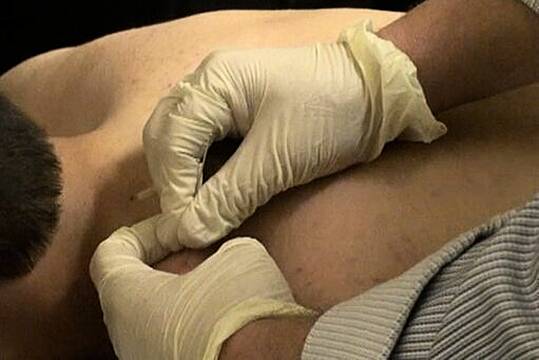Irish medics have warned of “the danger and potentially significant consequences of dry needling”.
This follows a 24-year-old newly graduated and off-duty junior doctor presenting at the A&E of the Midlands Regional Hospital in Mullingar with collapsed lungs after a dry needling session with her physiotherapist.
In a new paper in the February edition of the Irish Medical Journal (IMJ), co-authors Dr Bryan Dalton and Dr Chloe Swarbrigg state that while collapsed lungs after a dry needling session is a rarity, it “highlights the danger and potentially significant consequences of dry needling”.
"Given the increased popularity of dry needling, focus should be placed on highlighting the risk involved," they said.
The off-duty junior doctor - who is a non-smoker - had been suffering from shoulder and neck pain following her final year medical exams, and she attended a physiotherapist who performed trigger point deep dry needling targeting sensitive areas of tight muscles at the base of her neck, shoulders and middle of her back.
The physio inserted, in total, 12 sterile acupuncture needles in the woman’s back reaching a depth of 40mm.
However, over the next 12 hours, the off-duty junior doctor became symptomatic, coughing up blood and suffering from acute onset chest pain.
Becoming out of breath on exertion, the woman decided to attend hospital.
X-rays
Following x-rays of the woman’s lungs, medics diagnosed collapsed lungs or pneumothorax. This occurs when air leaks in the space between a person’s lung and chest wall, pushing on the outside of the lung and making it collapse.
The junior doctor remained in hospital for three days and medics first treated the collapsed lungs with supplemental oxygen “and a needle aspiration was performed on the right side with good effect”.
After being successfully treated, the patient was discharged with no further symptoms.
The medics stated that the part of the body targeted by the physio with the needles, along with the patient’s low normal Body Mass Index (BMI), made her high risk when considering the distance from skin to the pleura or the membrane covering the lungs.
In their paper, ‘Acupuncture D - Bilateral Pneumothoraces Following Dry Needling,’ the two medics state that their case is distinctive from others amongst the published literature as it is the only case of collapsed lungs after dry needling documented.
They state: “We must begin to fill the distinct lack of available literature surrounding the potential adverse effects of dry needling.”
The two medics state that dry needling is a technique that is relatively new when compared to acupuncture and thus a large gap in the literature exists, particularly regarding adverse events.
They state that whilst similar in appearance, dry needling and acupuncture are inherently different.
The two doctors state that the physiotherapist who carried out the dry needling in the case was made aware of the adverse effect and now being more informed, she will be more cognisant of adverse effects in the future.







